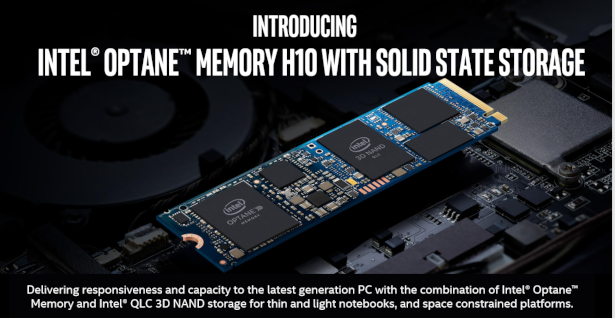Intel is announcing their newest Optane memory product, designated as Intel Optane Memory H10 with Solid State Storage. This unique device combines Intel Optane Memory technology with Intel QLC 3D NAND technology in a single M.2 x 2280 form factor offering. This new device offers Optane memory up to 32GB capacity, and Intel 3D NAND solid-state storage of up to 1TB capacity.
 The single-sided M.2 x 2280 circuit board for Intel’s latest features a nearly 50/50 split of PCB real estate for the Optane memory and for the solid-state drive portion. Viewed from the top side, the left half features the Intel Optane Memory and its associated controller. The right half features the Intel QLC 3D NAND media and its attendant controller.
The single-sided M.2 x 2280 circuit board for Intel’s latest features a nearly 50/50 split of PCB real estate for the Optane memory and for the solid-state drive portion. Viewed from the top side, the left half features the Intel Optane Memory and its associated controller. The right half features the Intel QLC 3D NAND media and its attendant controller.
 Intel’s Optane Memory H10 with Solid State Storage operates via a PCIe 3.0×4 with NVMe interface. It is rated for up to 300TBW endurance (over warranty). Sequential read speeds are stated as up to 2400MB/s, with sequential writes of up to 1800MB/s. Random 4K read speeds at QD1 are stated as up to 32,000 IOPS, with random 4K writes of up to 30,000 IOPS. At QD2, random 4K reads and writes improve to 55,000 IOPS. Intel is backing this new “hybrid” device with a five-year warranty.
Intel’s Optane Memory H10 with Solid State Storage operates via a PCIe 3.0×4 with NVMe interface. It is rated for up to 300TBW endurance (over warranty). Sequential read speeds are stated as up to 2400MB/s, with sequential writes of up to 1800MB/s. Random 4K read speeds at QD1 are stated as up to 32,000 IOPS, with random 4K writes of up to 30,000 IOPS. At QD2, random 4K reads and writes improve to 55,000 IOPS. Intel is backing this new “hybrid” device with a five-year warranty.
 Intel sees the uses cases for this new Optane Memory H10 with Solid State Storage as including mainstream gaming, office productivity and content creation. System requirements are for an 8th generation Intel Core U series processor combined with a motherboard featuring an Intel 300-series chipset with on-package PCH. The motherboard needs to have a PCIe-based (not SATA) M.2 slot, and requires Intel RST 17.2 drivers.
Intel sees the uses cases for this new Optane Memory H10 with Solid State Storage as including mainstream gaming, office productivity and content creation. System requirements are for an 8th generation Intel Core U series processor combined with a motherboard featuring an Intel 300-series chipset with on-package PCH. The motherboard needs to have a PCIe-based (not SATA) M.2 slot, and requires Intel RST 17.2 drivers.
 As far as capacity choices, Intel is creating three options:
As far as capacity choices, Intel is creating three options:
- 16GB Optane Memory with 256GB solid-state storage
- 32GB Optane Memory with 512GB solid-state storage
- 32GB Optane Memory with 1TB solid-state storage
 Systems featuring Intel Optane Memory H10 with Solid State Storage will be available through BestBuy OEMs such as Dell, HPI, ASUS and more beginning in Q2 of 2019. Pricing will be determined by the OEMs and BestBuy.
Systems featuring Intel Optane Memory H10 with Solid State Storage will be available through BestBuy OEMs such as Dell, HPI, ASUS and more beginning in Q2 of 2019. Pricing will be determined by the OEMs and BestBuy.
 The SSD Review The Worlds Dedicated SSD Education and Review Resource |
The SSD Review The Worlds Dedicated SSD Education and Review Resource | 
So.. Help me understand the role this module would take in an appropriately outfitted system.
Would this single module in an M.2 80mm slot take the place of memory and SSD for, say, the boot drive of a system and provide 32Gb of RAM and up to a TB of SSD storage all at the blistering speeds discussed here??
– That’s how I’m understanding this module from this review.. Thanks in advance…